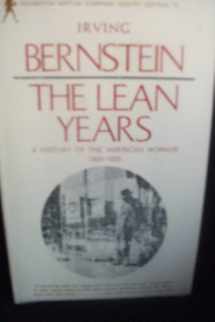
The Lean Years: A History of the American Worker, 1920-1933
ISBN-13:
9780395136577
ISBN-10:
0395136571
Author:
Irving Bernstein
Publication date:
1960
Publisher:
Houghton Mifflin (A Peter Davison Book)
Format:
Paperback
592 pages
FREE US shipping
Book details
ISBN-13:
9780395136577
ISBN-10:
0395136571
Author:
Irving Bernstein
Publication date:
1960
Publisher:
Houghton Mifflin (A Peter Davison Book)
Format:
Paperback
592 pages
Summary
The Lean Years: A History of the American Worker, 1920-1933 (ISBN-13: 9780395136577 and ISBN-10: 0395136571), written by authors
Irving Bernstein, was published by Houghton Mifflin (A Peter Davison Book) in 1960.
With an overall rating of 3.9 stars, it's a notable title among other
books. You can easily purchase or rent The Lean Years: A History of the American Worker, 1920-1933 (Paperback) from BooksRun,
along with many other new and used
books
and textbooks.
And, if you're looking to sell your copy, our current buyback offer is $0.43.
Description
Pre-eminent among historians of labor history.” Arthur Schlesinger, Jr.The textbook history of the 1920s is a story of Prohibition, flappers, and unbounded prosperity. For millions of industrial workers, however, the roaring twenties” looked very different. Working-class communities were already in crisis in the years before the stock market crash of 1929. Strikes in the 1920s and attempts to organize the unemployed and fight evictions in the early 1930s often fell victim to police violence and repression.Here, Irving Bernstein recaptures the social history of the decade leading up to Franklin Delano Roosevelt’s inauguration, uncovers its widespread inequality, and sheds light on the long-forgotten struggles that form the prelude to the great labor victories of the 1930s."In other words, viewed from afar, most of the people who were suffering the hardships of the Depression were depressed and even ashamed, ready to blame themselves for their plight. But the train of developments that connects changes in social conditions to a changed consciousness is not simple. People, including ordinary people, harbor somewhere in their memories the building blocks of different and contradictory interpretations of what it is that is happening to them, of who should be blamed, and what can be done about it. Even the hangdog and ashamed unemployed worker who swings his lunch box and strides down the street so the neighbors will think he is going to a job can also have other ideas that only have to be evoked, and when they are make it possible for him on another day to rally with others and rise up in anger at his condition.From the new introduction by Frances Fox Piven


We would LOVE it if you could help us and other readers by reviewing the book
Book review

Congratulations! We have received your book review.
{user}
{createdAt}
by {truncated_author}


